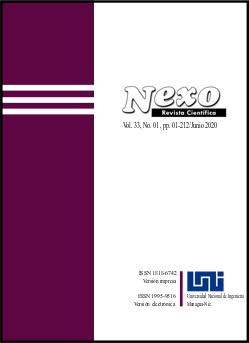Detección de la aplicación reempaquetada de android usando similaridad de imagenes
DOI:
https://doi.org/10.5377/nexo.v33i01.10058Palabras clave:
Aplicación de Android reempaquetada, Representación de imagen, Distancia porcentual de cadena de HashingResumen
La popularidad de Android trae muchas funcionalidades a sus usuarios, pero también trae muchas amenazas. La aplicación de Android reempaquetada es una de esas amenazas, que es la raíz de muchas otras amenazas, como malware, phishing, adware y pérdidas económicas. Anteriormente se han propuesto muchas técnicas para la detección de aplicaciones reempaquetadas, pero tienen sus limitaciones y cuellos de botella. En este trabajo, propusimos una técnica de detección de aplicaciones reempaquetadas basada en similitud de imagen. El trabajo propuesto utilizó la idea principal detrás del reempaquetado de la aplicación que es "el atacante quiere crear una aplicación falsa que se vea visualmente similar al original". Convertimos cada archivo APK en una imagen en escala de grises y luego usamos el hash perceptual para crear un hash de cada uno. imagen. Los algoritmos de distancia de cadena como la distancia de Hamming se usaron para calcular la distancia y buscar la aplicación reempaquetada. El trabajo propuesto también utilizó el cálculo de distancia en las características binarias extraídas de la aplicación. El trabajo propuesto es muy poderoso en términos de precisión de detección y escaneo velocidad y logramos 96% de precisión.
Descargas
1843
Descargas
Publicado
Cómo citar
Número
Sección
Licencia
Los autores que publican en Nexo Revista Científica están de acuerdo con los siguientes términos:
- Los autores conservan los derechos de autor y conceden a la revista el derecho de la primera publicación bajo la licencia Creative Commons Attribution License, que permite a otros compartir el trabajo con un reconocimiento a la autoría de la obra y a la publicación inicial en Nexo Revista Científica.
- Los autores pueden establecer por separado acuerdos adicionales para la distribución no exclusiva de la versión de la obra publicada en la revista (por ejemplo, en un repositorio institucional o en un libro) con el reconocimiento de su publicación inicial en Nexo Revista Científica.
- Se permite y se anima a los autores a difundir sus trabajos electrónicamente (por ejemplo, en repositorios institucionales o en su propio sitio web) antes y durante el proceso de envío, ya que puede dar lugar a intercambios productivos, así como a una citación más temprana y mayor de los trabajos publicados.










